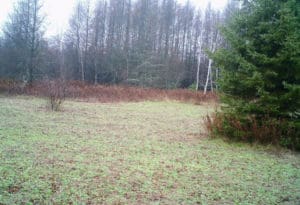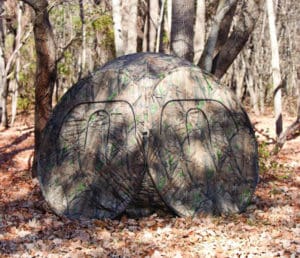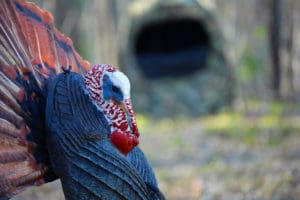Ground Blinds | Turkey Hunting Strategies to Make Life Easier
Big Game Tree Stands is Powered by Stone Road Media
What’s one phrase that realtors and anyone involved in the housing market repeatedly love to preach? “Location, location, location,” right? You’ve heard it all before, and can probably understand why this is true. But what do housing clichés have to do with turkey hunting and ground blinds? You can say the same thing about the best locations for your ground blind during turkey season. Of all the spring turkey hunting tips you hear about, it really all comes down to location, whether you’re hunting relatively unpressured, early season birds or extremely call-shy, late season birds.
Now you’re probably asking what the purpose of turkey decoys or calling tactics is if location is the most important factor. Those are extremely important details too, as we’ll look at below. But without the right location or hunting blind set up, you may be stacking the deck against yourself before you even head out into the woods. So if you’re wondering how to how to hunt turkeys in the spring, here are some tips for finding and taking advantage of these turkey hunting hot spots so you can have a better chance at adding a fan and beard to your wall soon.
Youth Season Turkey Hunting Success Out Of Ground Blinds
(video) A lot of turkey hunting action and a whole lot of youth hunting success. Using the ground blinds was critical to the success of these turkey hunters.
Ideal Turkey Habitat
Turkeys aren’t too picky about their habitat preferences, but there are a few things that help make for a tremendous property. First, there should be numerous roost trees on your hunting land. Basically any tall, open-branched tree should do the trick, but typically these include oaks, some maples, and white or red pine trees. Waterways, including streams, ditches, rivers, or ponds, are also a vital habitat feature for turkeys. These waterbodies not only provide a critical drinking source for them, but also support healthy trees, shrubs, and herbaceous vegetation.
The next thing they need is a good feeding area to sustain them beyond what foraging for native plants or leftover mast (e.g., acorns, wild grape, crabapples) might provide. People might not realize it, but up to 90% of a turkey’s diet consists of plant matter. Turkeys love spring food plots for that very reason, with clover being one of the more common species preferred in the spring. They will forage on the fresh green leaves, but also key in on the newly emerging insects because of their high protein content. This makes clover plots attractive not only for deer, but also for turkey hunting.
 Turkeys also prefer shorter-cropped or more open-growing vegetation as opposed to wading through dense long grasses (cool season grasses like reed canary). This type of growth is more difficult for hens with poults to travel through and reduces their visibility from predators. However, hens will still nest in areas with good side cover, provided it is within proximity to feeding areas, early successional habitat, open understory shrublands, or mature woodlands with little herbaceous growth.
Turkeys also prefer shorter-cropped or more open-growing vegetation as opposed to wading through dense long grasses (cool season grasses like reed canary). This type of growth is more difficult for hens with poults to travel through and reduces their visibility from predators. However, hens will still nest in areas with good side cover, provided it is within proximity to feeding areas, early successional habitat, open understory shrublands, or mature woodlands with little herbaceous growth.Best Ground Blind Locations
Now that you’re familiar with where turkeys like to live, we’ll discuss some good spots for you to set up your ground blinds to maximize a shot opportunity. As we mentioned, even the best calling and turkey decoy placement won’t do much for you if you set up in a spot where turkeys naturally don’t like to go. You’ll be forcing them to go out of their way to come to you, and it’s a losing battle more often than not. On the other hand, if wild turkeys already prefer certain locations and you can set up adjacent to or between these areas, you’re not making them do anything different from their normal routine. The only difference is that there will be a sweet-talking hen decoy at their usual hangout. And that’s a recipe for success when you’re hunting for turkeys.
 Open fields in the form of food plots, pastures, meadows, or hay fields draw turkeys during spring mornings to eat and toms will often choose one of these locations as a strutting zone. However, Eastern wild turkeys will rarely feel comfortable venturing into the center of large fields, and more often prefer openings smaller than 5 acres. Because of this tendency, you should focus your effort on the edges. Set up your Quantum ground blind on the edge of one of these fields, flanked by shrubs and trees to break up the outline further. The blind is surprisingly lightweight at only 11 pounds, and sets up in short order due to its spring steel frame. Place your decoys in the open field about 10 to 15 yards in front of your shooting window. Face the decoys quartering away from you in whatever direction you anticipate gobblers to come from.
Open fields in the form of food plots, pastures, meadows, or hay fields draw turkeys during spring mornings to eat and toms will often choose one of these locations as a strutting zone. However, Eastern wild turkeys will rarely feel comfortable venturing into the center of large fields, and more often prefer openings smaller than 5 acres. Because of this tendency, you should focus your effort on the edges. Set up your Quantum ground blind on the edge of one of these fields, flanked by shrubs and trees to break up the outline further. The blind is surprisingly lightweight at only 11 pounds, and sets up in short order due to its spring steel frame. Place your decoys in the open field about 10 to 15 yards in front of your shooting window. Face the decoys quartering away from you in whatever direction you anticipate gobblers to come from.
A location that sets up similar to this includes smaller forest openings or recent clearcuts, but you need to make some adjustments to your strategy. Forest openings may be significantly smaller than open field settings, so you’ll be tucked in closer to the action. Take some time to brush in your ground blinds so that they blend in seamlessly with the surrounding cover. We’ll discuss that further below.
Another important area you should hunt is between roosting and feeding areas. You can often catch turkeys working their way from roost trees to the feeding areas in the early morning hours. After you’ve roosted a gobbler by using an owl or crow call, you’ll need to quickly get to your blind very stealthily. You should set some walking hen decoys out so that they’re facing the feeding area, and ideally use some fishing line to add a little movement to them. Once there’s enough shooting light, feel free to call aggressively using cuts and yelps with the occasional fighting purr tossed in. Calling spring gobblers isn’t as difficult as it seems if you stick to these three basic calls. That should convince almost any roosted tom to fly down and check it out.
If the morning hunts don’t work out in your favor, it’s not too late. Afternoon turkey hunting can also produce some exciting action, depending on the location you choose to hunt. First, realize that turkeys will get more cautious as they return to their roost trees, as they don’t want to attract the attention of a predator right before bedtime. As a result, dial down your calling efforts as the afternoon sun starts to dip lower in the sky. To still catch some good turkey action, set your ground blind up on a travel route between the feeding and roosting sites, but nearer to the food source where the gobblers will still eat and strut a bit before retiring for the day. One of the best afternoon turkey hunting tips is to not set up too close to the roost trees, because you’ll probably not hear them approach and you’ll disturb them when you leave for the night.

No comments:
Post a Comment